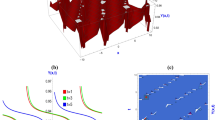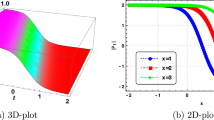Abstract
General high-order rogue waves of the nonlinear Schrödinger–Boussinesq equation are obtained by the KP-hierarchy reduction theory, and the N-order rogue waves are expressed with the determinants, whose entries are all algebraic forms, which is shown in the theorem. It is found that the fundamental first-order rogue waves can be classified into three patterns: four-petal state, dark state, bright state by choosing different values of parameter \(\alpha \). An interesting phenomenon is discovered as the evolution of the parameter \(\alpha \): the rogue wave changes from four-petal state to dark state, whereafter bright state, which are consistent with the change in the corresponding critical points to the function of two variables. Furthermore, the dynamical property of second-order and third-order rogue waves is plotted, which can be regarded as the nonlinear superposition of the fundamental first-order rogue waves.








Similar content being viewed by others
References
Onorato, M., Osborne, A.R., Srio, M.: Modulational instability in crossing sea states: a possible mechanism for the formation of freak waves. Phys. Rev. Lett. 96, 014503 (2006)
Baronio, F., Conforti, M., Degasperis, A., Lombardo, S., Onorato, M., Wabnitz, S.: Vector rogue waves and baseband modulation instability in the defocusing regime. Phys. Rev. Lett. 113, 034101 (2014)
Peterson, P., Soomere, T., Engelbrecht, J., Groesen, E.V.: Soliton interaction as a possible model for extreme waves in shallow water. Nonlinear Process. Geophys. 10, 503–510 (2003)
Pelinovsky, E., Kharif, C., Talipova, T.: Large-amplitude long wave interaction with a vertical wall. Eur. J. Mech. B Fluid 27, 409–418 (2008)
Solli, D.R., Ropers, C., Koonath, P., Jalali, B.: Optical rogue waves. Nature 450, 1054–1058 (2007)
Pierangeli, D., Mei, F.D., Conti, C., Agranat, A.J., DelRe, E.: Spatial rogue waves in photorefractive ferroelectrics. Phys. Rev. Lett. 115, 093901 (2015)
Akhmediev, N., Dudley, J.M., Solli, D.R., Turitsyn, S.K.: Recent progress in investigating optical rogue waves. J. Opt. 15, 060201 (2013)
Bludov, Y.V., Konotop, V.V., Akhmediev, N.: Matter rogue waves. Phys. Rev. A 80, 033610 (2009)
Moslem, W.M.: Langmuir rogue wave in electron–positron plasmas. Phys. Plasmas 18, 032301 (2011)
Yan, Z.Y.: Vector financial rogue waves. Phys. Lett. A 375, 4274–4279 (2011)
Ohta, Y., Yang, J.K.: Genera high-order rogue wvae and their dynamics in the nonlinear Schrödinger equation. Proc. R. Soc. Lond. Sect. A 468, 1716–1740 (2012)
Akhmediev, N., Ankiewicz, A., Soto-Crespo, J.M.: Rogue waves and rational solutions of the nonlinear Schrödinger equation. Phys. Rev. E 80, 026601 (2009)
Guo, B.L., Ling, L.M., Liu, Q.P.: High-order solution and generalized Darboux transformation of derivative nonlinear Schrödinger equation. Stud. Appl. Math. 130, 317–344 (2012)
Ling, L.M., Guo, B.L., Zhao, L.C.: High-order rogue waves in vector nonlinear Schrödinger equation. Phys. Rev. E 89, 041201 (2014)
Xu, S.W., He, J.S., Wang, L.H.: The Darboux transformation of the derivative nonlinear Schrödinger equation. J. Phys. A Math. Theor. 44, 305203 (2011)
Wang, Y.Y., Liang, C., Dai, C.Q., Zheng, J., Fan, Y.: Exact vector multipole and vortex solitons in the media with spatially modulated cubic–quintic nonlinearity. Nonlinear Dyn. 90, 1269–1275 (2017)
Dai, C.Q., Zhou, G.Q., Chen, R.P., Lai, X.J., Zheng, J.: Vector multipole and vortex solitons in two-dimensional Kerr media. Nonlinear Dyn. 88, 2629–2635 (2017)
Dai, C.Q., Wang, Y.Y., Fan, Y., Yu, D.G.: Reconstruction of stability for Gaussian spatial solitons in quintic–septimal nonlinear materials under PT-symmetric potentials. Nonlinear Dyn. 92, 1351–1358 (2018)
Peregrine, D.H.: Water waves, nonlinear Schrödinger equations and their solutions. J. Aust. Math. Soc. B 25, 16–43 (1983)
Kibler, B., Fatome, J., Finot, C., Millot, G., Dias, F., Genty, G., Akhmediev, N., Dudley, J.M.: The peregrine soliton in nonlinear fibre optics. Nat. Phys. 6, 790–795 (2010)
Zhao, L.C., Xin, G.G., Yang, Z.Y.: Rogue-wave pattern transition induced by relative frequency. Phys. Rev. E 90, 022918 (2014)
Chabchoub, A., Hoffmann, N., Onorato, M., Slunyaev, A., Sergeeva, A., Pelinovsky, E., Akhmediev, N.: Observation of hierarchy of up to fifth-order rogue waves in a water tank. Phys. Rev. E 86, 056601 (2012)
Guo, B.L., Ling, L.M.: Rogue wave, breathers and bright–dark-rogue solutions for the coupled Schrödinger equations. Chin. Phys. Lett. 28, 110202 (2011)
Zhang, G.Q., Yan, Z.Y., Wen, X.Y., Chen, Y.: Interactions of localized wave structures and dynamics in the defocusing coupled nonlinear Schrödinger equations. Phys. Rev. E 95, 042201 (2017)
Xu, T., Chen, Y., Lin, J.: Localized waves of the coupled cubic-quintic nonlinear Schrödinger equations in nonlinear optics. Chin. Phys. B 26, 120200 (2017)
Wei, J., Wang, X., Geng, X.G.: Periodic and rational solutions of the reduced Maxwell–Bloch equations. Commun. Nonlinear Sci. Numer. Simul. 59, 1–14 (2017)
Liu, Y.K., Li, B., An, H.L.: General high-order breathers, lumps in the (\(2+1\))-dimensional Boussinesq equation. Nonlinear Dyn. (2018). https://doi.org/10.1007/s11071-018-4181-6
Zhang, X.E., Chen, Y., Tang, X.Y.: Rogue wave and a pair of resonance stripe solitons to a reduced generalized (\(3+1\))-dimensional KP equation. arXiv:1610.09507
Zhang, X.E., Chen, Y.: Rogue wave and a pair of resonance stripe solitons to a reduced (\(3+1\))-dimensional Jimbo–Miwa equation. Commun. Nonlinear Sci. Numer. Simul. 52, 24–31 (2017)
Zhang, X.E., Chen, Y.: Deformation rogue wave to the (\(2+1\))-dimensional KdV equation. Nonlinear Dyn. 90, 755–763 (2017)
Jimbo, M., Miwa, T.: Solitons and infinite dimensional Lie algebras. Publ. RIMS Kyoto Univ. 19, 943–1001 (1983)
Ohta, Y.: Wronskian solutions of soliton equations. RIMS kôkyûroku 684, 1–17 (1989)
Ohta, Y., Wang, D.S., Yang, J.K.: General \(N\)-dark–dark solitons in the coupled nonlinear Schrödinger equations. Stud. Appl. Math. 127, 345–371 (2011)
Feng, B.F.: General \(N\)-soliton solution to a vector nonlinear Schrödinger equation. J. Phys. A Math. Theor. 47, 355203 (2014)
Ling, L.M., Zhao, L.C., Guo, B.L.: Darboux transformation and multi-dark soliton for \(N\)-component nonlinear Schrödinger equations. Nonlinearity 28, 3243–3261 (2015)
Chen, J.C., Chen, Y., Feng, B.F., Maruno, K.I., Ohta, Y.: An integrable semi-discretization of the coupled Yajima–Oikawa system. J. Phys. A Math. Theor. 49, 165201 (2016)
Chen, J.C., Chen, Y., Feng, B.F., Maruno, K.I., Ohta, Y.: General high-order rogue waves of the (\(1+1\))-dimensional Yajima–Oikawa system. arXiv:1709.03781
Chen, J.C., Chen, Y., Feng, B.F., Maruno, K.I.: Rational solutions to two-and one-dimensional multicomponent Yajima–Oikawa systems. Phys. Lett. A 379, 1510–1519 (2015)
Chen, J.C., Feng, B.F., Chen, Y., Ma, Z.Y.: General bright–dark soliton solutions to (\(2+1\))-dimensional multi-component long-wave–short-wave resonance interaction system. Nonlinear Dyn. 88, 1–16 (2017)
Han, Z., Chen, Y., Chen, J.C.: General \(N\)-dark soliton solutions of the multi-component Mel’nikov system. J. Phys. Soc. Jpn. 86, 074005 (2017)
Han, Z., Chen, Y., Chen, J.C.: Bright-dark mixed \(N\)-soliton solutions of the multi-component mel’nikov system. J. Phys. Soc. Jpn. 86, 104008 (2017)
Sun, B.N., Wazwaz, A.M.: Interaction of lumps and dark solitons in the Mel’nikov equation. Nonlinear Dyn. (2018). https://doi.org/10.1007/s11071-018-4180-7
Wazwaz, A.M.: Multiple soliton solutions and multiple complex soliton solutions for two distinct Boussinesq equations. Nonlinear Dyn. 85, 731–737 (2016)
Wazwaz, A.M., El-Tantawy, S.A.: Solving the (\(3+1\))-dimensional KP-Boussinesq and BKP-Boussinesq equations by the simplified Hirota’s method. Nonlinear Dyn. 88, 3017–3021 (2017)
Rao, N.N.: Exact solutions of coupled scalar field equations. J. Phys. A Math. Gen. 22, 4813–4825 (1989)
Singh, S.V., Rao, N.N., Shukla, P.K.: Nonlinearly coupled Langmuir and dust-acoustic waves in a dusty plasma. J. Plasma Phys. 3, 551–567 (1998)
Hase, Y., Satsuma, J.: An \(N\)-soliton solutions for the nonlinear Schrödinger equation coupled to the Boussinesq equation. J. Phys. Soc. Jpn. 57, 679–682 (1988)
Mu, G., Qin, Z.Y.: Rogue waves for the coupled Schrödinger–Boussinesq equation and the coupled higgs equation. J. Phys. Soc. Jpn. 81, 084001 (2012)
Lu, C.N., Fu, C., Yang, H.W.: Time-fractional generalized Boussinesq equation for Rossby solitary waves with dissipation effect in stratified fluid and conservation laws as well as exact solutions. Appl. Math. Comput. 327, 104–116 (2018)
Xu, X.X.: An integrable coupling hierarchy of the Mkdv-integrable systems, its hamiltonian structure and corresponding nonisospectral integrable hierarchy. Appl. Math. Comput. 216, 344–353 (2010)
Xu, T., Chen, Y.: Darboux transformation of the coupled nonisospectral Gross–Pitaevskii system and its multi-component generalization. Commun. Nonlinear Sci. Numer. Simul. 57, 276–289 (2018)
Tang, L.Y., Fan, J.C.: A family of liouville integrable lattice equations and its conservation laws. Appl. Math. Comput. 217, 1907–1912 (2010)
Li, X.Y., Li, Y.X., Yang, H.X.: Two families of liouville integrable lattice equations. Appl. Math. Comput. 217, 8671–8682 (2011)
Acknowledgements
We would like to express our sincere thanks to SY Lou, WX Ma, EG Fan, ZY Yan, XY Tang, JC Chen, X Wang and other members of our discussion group for their valuable comments.
Author information
Authors and Affiliations
Corresponding author
Ethics declarations
Conflict of interest
The authors declare that there is no conflict of interests regarding the publication of this paper.
Additional information
The project is supported by the Global Change Research Program of China (No. 2015CB953904), National Natural Science Foundation of China (Nos. 11435005, 11675054), Shanghai Collaborative Innovation Center of Trustworthy Software for Internet of Things (No. ZF1213).
Appendix A
Appendix A
In this appendix, we will give the proof to the lemma in Sect. 3 with the KP reduction theory. The detail is as follows:
Proof
Based on the solution of the bilinear KP-hierarchy (4), let us bring in the functions with the following form
where
in addition, these functions should be satisfied the differential form
Then introduce a new entries of the matrix composed by two differential operators:
It is clear that the operators \(A_i^{\mu }, B_{j}^{\nu }\) can commute with the differential operator \(\partial _{x_1}, \partial _{x_{-1}}, \partial _{x_2}, \partial _{x_3}\), so these functions are suit for the bilinear KP-hierarchy (3). Furthermore, for an arbitrary \((i_1, i_2, \ldots i_N;\) \(\mu _1, \mu _2, \ldots , \mu _N, j_1, j_2, \ldots , j_N, \nu _1, \nu _2, \ldots , \nu _N)\), the corresponding determinant
is satisfied the bilinear KP-hierarchy, especially, when \(\hat{\tau }_n=\underset{1\le i,j\le N}{\text{ det }}\left( \hat{m}_{2i-1,2j-1}^{N-i,N-j,n}\right) \), it is also the solution. Based on the Leibniz rule, one can get
and
Hence, one can obtain the commutator operation
where \(\left[ ,\right] \) devotes the commutator given by \(\left[ X,Y\right] =XY-YX\).
Suppose \(\theta \) is the solution of the quadratic dispersion equation
then the commutator operation equals to zero when \(k=0, 1\),
When \(k\ge 2\):
Thus, there exists a recurrence relation between the two differential operators
spontaneously, when \(k<0\), this operator \(A_{k}^{(\mu )}=0\).
Similarly, it is obviously that the differential operator \(B_{l}^{(\nu )}\) also satisfies
when \(l>0\), and when \(l<0\), we define \(B_{l}^{(\nu )}=0.\)
Under the above two recurrence equation, the following derivative relation can be derived as:
Once more, based on the above relation, the differential form of a special determinant rewritten as
can be worked out as
where \(\triangle _{ij}\) is the (i, j)-cofactor of the matrix \(\left( \hat{m}_{2i-1,2j-1}^{N-i,N-j,n}\right) \). It is obvious that \(\sum _{i=1}^{N}\sum _{j=1}^{N}\triangle _{ij}\hat{m}_{2i-3,2j-1}^{(N-i+1,N-j,n)}\big |_{p=\theta ,q=\theta ^*}=0\) for \(\triangle _{ij}\) is the (i, j)-cofactor of the matrix \(\left( \hat{m}_{2i-1,2j-1}^{N-i,N-j,n}\right) \) but not the \(\left( \hat{m}_{2i-3,2j-1}^{N-i+1,N-j,n}\right) \). Similarly, \(\sum _{i=1}^{N}\sum _{j=1}^{N}\triangle _{ij}\hat{m}_{2i-1,2j-3}^{(N{-}i,N{-}j{+}1,n)}\big |_{p=\theta ,q=\theta ^*}=0.\) Therefore, Eq. (41) will be changed into
Due to \(\hat{\hat{\tau }}_n\) is a special case of \(\hat{\tau }_n\), so \(\hat{\hat{\tau }}_n\) is the solution to the (\(1+1\))-dimensional bilinear equation:
Under reduction Eq. (42), these variables \(x_{-1}, x_{3}\) in \(\hat{\hat{\tau }}_n\) will become dummy. Thus, the matrix entries \(\hat{m}_{2N-i,2N-j}^{(N-i,N-j,n)}\) reduce to \(m^{(N-i,N-j,n)}_{2N-i,2N-j}\), \(\tau _n\) in Eq. (11) satisfy Eq. (6), and the proof is completed. \(\square \)
Rights and permissions
About this article
Cite this article
Zhang, X., Chen, Y. General high-order rogue waves to nonlinear Schrödinger–Boussinesq equation with the dynamical analysis. Nonlinear Dyn 93, 2169–2184 (2018). https://doi.org/10.1007/s11071-018-4317-8
Received:
Accepted:
Published:
Issue Date:
DOI: https://doi.org/10.1007/s11071-018-4317-8




